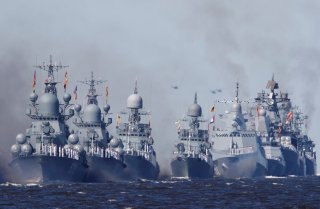Why the Russian Navy Loves Hypersonic Missiles
The Russian Navy conducted a number of hypersonic missile launches in the final months of 2020, including three from October to December. In those tests, Tsirkon missiles were fired from the 3S-14 universal naval missile launchers installed on Project 22350 frigates and Project 20380 corvettes.
The Russian Navy conducted a number of hypersonic missile launches in the final months of 2020, including three from October to December. In those tests, Tsirkon missiles were fired from the 3S-14 universal naval missile launchers installed on Project 22350 frigates and Project 20380 corvettes.
Now the Project 22350 lead frigate Admiral Gorshkov, which is operational with the Russian Navy's Northern Fleet's division of missile ships, has reportedly deployed to the Barents Sea for test-launches of Tsirkon hypersonic missiles.
"The crew of the frigate Admiral Gorshkov has deployed to the Barents Sea where it will practice some elements of a combat training course and conduct firings from its missile and artillery weapons against sea targets," the Northern Fleet's press office said in a statement, according to Tass.
The warship had performed several of last year's Tsirkon hypersonic cruise missile tests. After this upcoming test in the Barents Sea, the frigate will return to its home naval base of Severomorsk. In December, Russian Deputy Defense Minister Alexei Krivoruchko said in an interview with the Krasnaya Zvezda newspaper that serial deliveries of Tsirkon hypersonic missiles to the Russian troops will begin in 2022.
"Trials of a missile system with a Tsirkon hypersonic missile proceed successfully," Krivoruchko added. "A series of successful Tsirkon launches by the Admiral Gorshkov frigate were carried out in 2020. Their serial deliveries will begin in 2022."
Russian President Vladimir Putin has touted the capabilities of hypersonic missiles, and in his February 2019 address to the Russian parliament, the Russian leader highlighted the capabilities of the weapons platform. Putin claimed the Tsirkon can reach speeds of Mach 9 and is able to hit both naval and ground-based targets from a distance greater than 1,000 km.
Putin has also indicated that the 3S-14 universal naval missile launchers could be employed on a number of Russian warships. To date, most of the testing has been conducted via the Project 22350 lead frigate The Admiral of the Fleet of the Soviet Union Gorshkov.
Named after Hero of the Soviet Union Sergey Gorshkov, who oversaw the expansion of the Soviet Navy into a global force during the Cold War, the lead frigate is considered to be among the Northern Fleet's most advanced warships. It was built at the Severnaya Shipyard in St. Petersburg in Russia's northwest and entered service in July 2018. The vessel displaces 4,500 tonnes and can reach speeds of 29 knots. The multi-purpose combat ship is armed with Oniks and Kalibr missile launchers, and also with Poliment-Redut surface-to-air missile systems, and is capable of effectively fighting enemy surface ships, aircraft and submarines and delivering strikes against ground and coastal installations to a range of over 1,500 km.
On her maiden distant deployment, the ship traveled some 35,000 nautical miles and completed the first globe circumnavigation the Russian Navy had performed since Stepan Makarov's 1886–1889 voyage on the corvette Vityaz.
Peter Suciu is a Michigan-based writer who has contributed to more than four dozen magazines, newspapers and websites. He regularly writes about military small arms, and is the author of several books on military headgear including A Gallery of Military Headdress, which is available on Amazon.com.

